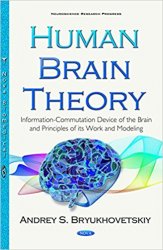Human Brain Theory: Information-commutation Device of the Brain and Principles of Its Work and Modeling
- Добавил: harun54
- Дата: 19-01-2019, 22:49
- Комментариев: 0
 Название: Human Brain Theory: Information-commutation Device of the Brain and Principles of Its Work and Modeling
Название: Human Brain Theory: Information-commutation Device of the Brain and Principles of Its Work and ModelingАвтор: Andrey S. Bryukhovetskiy
Издательство: Nova Science Publishing
Год: 2016
Формат: PDF
Размер: 12 Мб
Язык: английский / English
The book was written as an attempt to find the solution to one of the most complex and unsolved issues of the human anatomy: the understanding of the human brain and the principles according to which it operates. Currently, it is important to look at the challenge in an alternatively non-standard, yet still systemic way, paying less attention to details and outlining the ways out of this crisis of neuroscience.
The purpose of this monograph is to describe the author's theory about the brain's architecture and operation to the medical and scientific community. Accompanied with extensive clinical, research and training experience, the author's theoretical concepts of the brain synthesized with scientific evidence brought about the conclusion that low efficiency in neurologic therapy and mental diseases; the inability to work out mathematical models and simulations that could compete with the human brain; an academic dead end in the development of artificial intelligence; as well as high energy consumption of the computing innovations were conditioned by the inaccurate methodology and outdated anatomical and physiological views of the neurologists and neuroscientists on information processing in the brain, registration of memories and basic functions of the key morphological structures of the brain.
The morphological structure and physiological functions of all known anatomical formations of the brain were defined in the late nineteenth century. Since then, these functions have been accepted as dogmatic.
The book shows that present day multi-level neuroresearch relies on the foundation of systemic, morphofunctional and neuroanatomic knowledge about the brain structure. It looks for correlations between genome and post-genome data of molecular research in the brain tissue, as well as with neuropsychological and cognitive data; that is, the book intends to integrate the non-integrable into unified information space. The systemic approach in neuroresearch has become outdated by now and interferes with scientific development.
The information approach in the author's research of the genome, transcriptome, proteome in health and in disease permitted the analysis of the inductivity and magnetization of the nervous tissue. It also provided the explanation for targeted movement of the data in the module of the nervous tissue. The author came to the conclusion that gene, protein and neural networks "confused and chained" the pathways of scientific thought. Neural networks are only logistic constructions to provide data transfer in the brain between different modules of the nervous tissue. The author presumes that the funds invested in the development of brain simulations and artificial intelligence will hardly result in the expected advantages. If we are unable to step over the stereotypes of the systemic, morphofunctional research of the previous century, no progress shall come about. The author's theoretical survey resulted in the unique information-commutation theory of the brain and formulation of the key principles of brain operation. As a clinician and professor of neurology, the author underpins his theory with clinical examples.
Внимание
Уважаемый посетитель, Вы зашли на сайт как незарегистрированный пользователь.
Мы рекомендуем Вам зарегистрироваться либо войти на сайт под своим именем.
Уважаемый посетитель, Вы зашли на сайт как незарегистрированный пользователь.
Мы рекомендуем Вам зарегистрироваться либо войти на сайт под своим именем.
Информация
Посетители, находящиеся в группе Гости, не могут оставлять комментарии к данной публикации.
Посетители, находящиеся в группе Гости, не могут оставлять комментарии к данной публикации.
